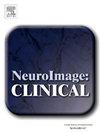Impaired spatial dynamic functional network connectivity and neurophysiological correlates in functional hemiparesis
IF 3.6
2区 医学
Q2 NEUROIMAGING
引用次数: 0
Abstract
The present study investigated spatial dynamic functional network connectivity (dFNC) in patients with functional hemiparesis (i.e., functional stroke mimics, FSM). The aim of this work was to assess static functional connectivity (large-scale) networks and dynamic brain states, which represent distinct dFNC patterns that reoccur in time and across subjects. Resting-state fMRI data were collected from 15 patients with FSM (mean age = 42.3 ± 9.4, female = 80 %) and 52 age-matched healthy controls (HC, mean age = 42.1 ± 8.6, female = 73 %).
Each patient underwent a resting-state functional MRI scan for spatial dFNC evaluation and transcranial magnetic stimulation protocols for indirect assessment of GABAergic and glutamatergic transmission. We considered three dynamic brain networks, i.e., the somatomotor network (SMN), the default mode network (DMN) and the salience network (SN), each summarized into four distinct recurring spatial configurations. Compared to HC, patients with FSM showed significant decreased dwell time, e.g. the time each individual spends in each spatial state of each network, in state 2 of the SMN (HC vs. FSM, 13.5 ± 27.1 vs. 1.9 ± 4.1, p = 0.044). Conversely, as compared to HC, FSM spent more time in state 1 of the DMN (10.8 ± 14.9 vs. 27.3 ± 38.9, p = 0.037) and in state 3 of the SN (23.1 ± 23.0 vs. 38.8 ± 38.2, p = 0.002). We found a significant correlation between the dwell time of impaired functional state of the SMN and measures of GABAergic neurotransmission (r = 0.581, p = 0.037). Specifically, longer impaired dwell time was associated with greater GABAergic inhibition. These findings demonstrate that FSM present altered functional brain network dynamics, which correlate with measures of GABAergic neurotransmission. Both dFNC and GABAergic neurotransmission may serve as potential targets for future intervention strategies.
功能性偏瘫的空间动态功能网络连通性受损和神经生理相关。
本研究探讨了功能性偏瘫(即功能性卒中模拟,FSM)患者的空间动态功能网络连接(dFNC)。这项工作的目的是评估静态功能连接(大规模)网络和动态大脑状态,它们代表不同的dFNC模式,这些模式在时间和不同的受试者中重复出现。静息状态fMRI数据来自15例FSM患者(平均年龄= 42.3±9.4,女性= 80%)和52例年龄匹配的健康对照(HC,平均年龄= 42.1±8.6,女性= 73%)。每位患者均接受静息状态功能MRI扫描以评估空间dFNC和经颅磁刺激方案,间接评估gaba能和谷氨酸能的传递。我们考虑了三种动态的大脑网络,即躯体运动网络(SMN),默认模式网络(DMN)和显著性网络(SN),每个网络都归纳为四种不同的重复空间配置。与HC相比,FSM患者的停留时间显著减少,即每个个体在每个网络的每个空间状态中停留的时间,SMN状态2 (HC vs FSM, 13.5±27.1 vs 1.9±4.1,p = 0.044)。相反,与HC相比,FSM在DMN状态1(10.8±14.9 vs. 27.3±38.9,p = 0.037)和SN状态3(23.1±23.0 vs. 38.8±38.2,p = 0.002)的时间更长。我们发现SMN功能受损状态的停留时间与gaba能神经传递测量之间存在显著相关性(r = 0.581, p = 0.037)。具体来说,受损停留时间越长,gaba能抑制程度越高。这些发现表明FSM改变了功能性脑网络动力学,这与gaba能神经传递的测量相关。dFNC和gaba能神经传递均可作为未来干预策略的潜在目标。
本文章由计算机程序翻译,如有差异,请以英文原文为准。
求助全文
约1分钟内获得全文
求助全文
来源期刊

Neuroimage-Clinical
NEUROIMAGING-
CiteScore
7.50
自引率
4.80%
发文量
368
审稿时长
52 days
期刊介绍:
NeuroImage: Clinical, a journal of diseases, disorders and syndromes involving the Nervous System, provides a vehicle for communicating important advances in the study of abnormal structure-function relationships of the human nervous system based on imaging.
The focus of NeuroImage: Clinical is on defining changes to the brain associated with primary neurologic and psychiatric diseases and disorders of the nervous system as well as behavioral syndromes and developmental conditions. The main criterion for judging papers is the extent of scientific advancement in the understanding of the pathophysiologic mechanisms of diseases and disorders, in identification of functional models that link clinical signs and symptoms with brain function and in the creation of image based tools applicable to a broad range of clinical needs including diagnosis, monitoring and tracking of illness, predicting therapeutic response and development of new treatments. Papers dealing with structure and function in animal models will also be considered if they reveal mechanisms that can be readily translated to human conditions.
 求助内容:
求助内容: 应助结果提醒方式:
应助结果提醒方式:


